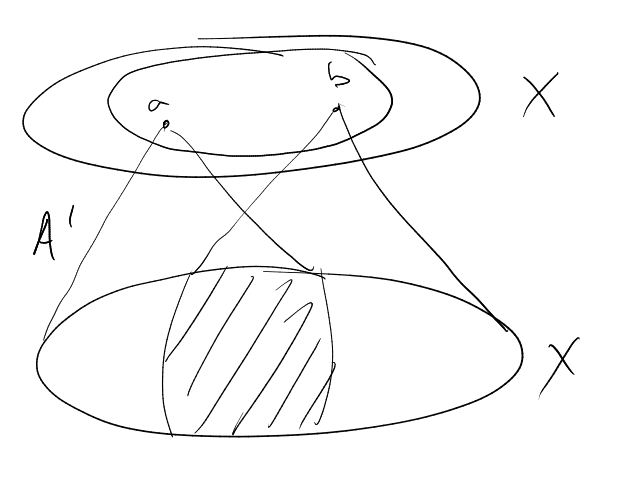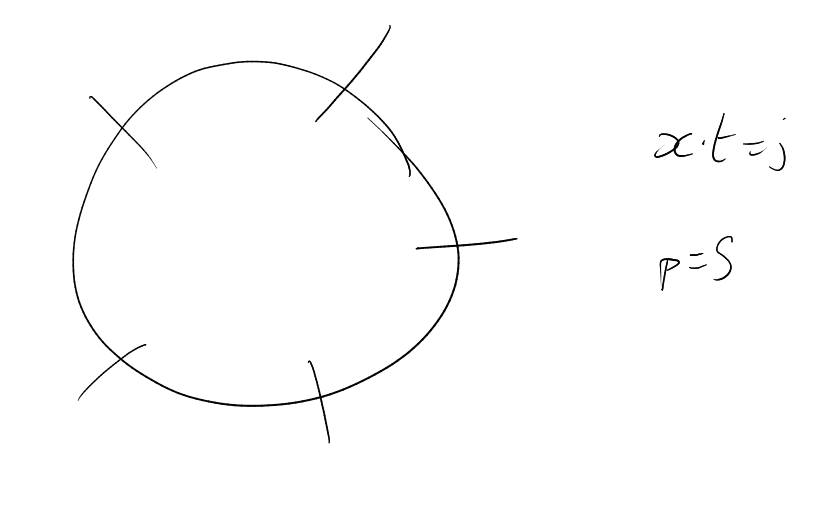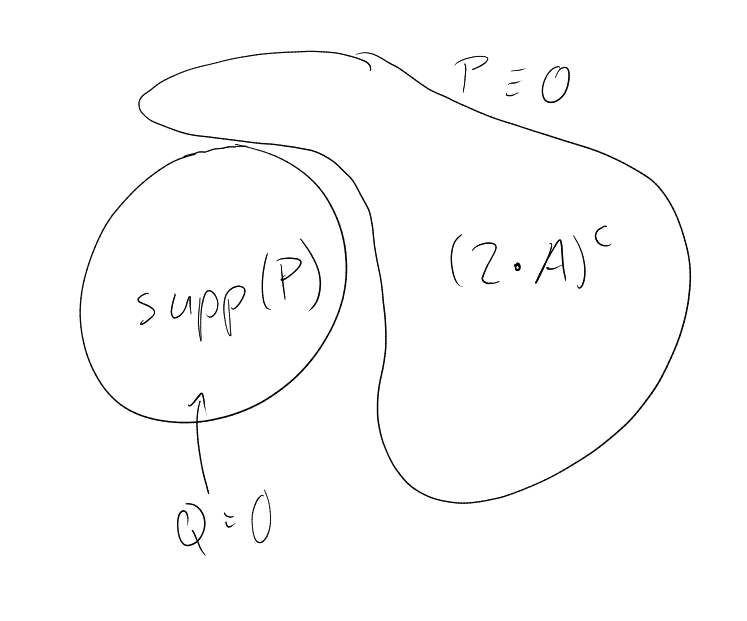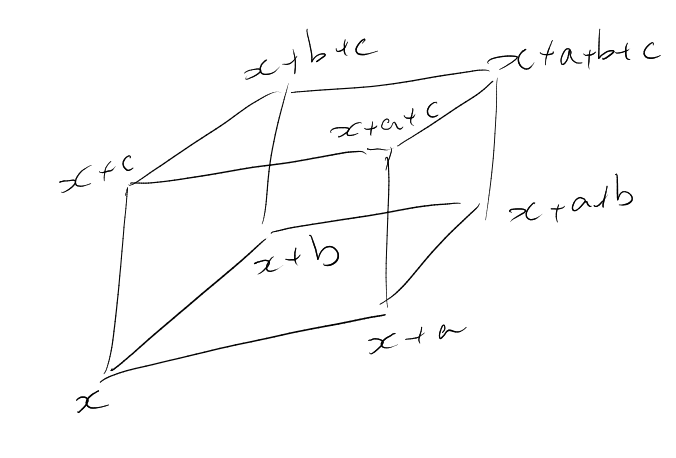Introduction to
Additive Combinatorics
Daniel Naylor
Contents
1 Combinatorial methods
Definition 1.1 (Sumset).
Let
be an abelian group. Given ,
define the sumset
to be
and the difference set
to be
If and
are
finite, then certainly
|
|
Example 1.2.
Let .
Then
|
|
Lemma 1.3.
Assuming that:
Then , with equality
if and only if
is an arithmetic progression.
Proof.
Let
with .
Then
|
|
so . But
we could also have written
|
|
When ,
these two orderings must be the same. So
for all .
□
Exercise: If , then
with equality
if and only if
and are
arithmetic progressions with the same common difference.
Example 1.4.
Let
with prime.
Then .
Indeed,
(note that
means ).
But ,
|
|
Theorem 1.5 (Cauchy-Davenport).
Assuming that:
-
is a prime
-
nonempty
Proof.
Assume .
Without loss of generality assume that
and that .
Apply induction on .
The case
is trivial. Suppose ,
and let .
Since
and ,
there must exist
such that
but .
Let ,
so ,
,
.
But , so the inductive
hypothesis applies to
and .
Since
we have
|
|
This fails for general abelian groups (or even general cyclic groups).
Example 1.6.
Let be
(fixed, small) prime, and let
be a subspace. Then ,
so . In fact,
if is such
that ,
then
must be a coset of a subspace.
Example 1.7.
Let
be such that .
Then there exists
a subspace such that
and is contained
in a coset of .
See Example Sheet 1.
Definition 1.8 (Ruzsa distance).
Given finite sets
, we define the
Ruzsa distance
between
and by
Note that this is symmetric, but is not necessarily non-negative, so we cannot prove that it is a metric. It
does, however, satisfy triangle inequality:
Lemma 1.9 (Ruzsa’s triangle inequality).
Assuming that:
Proof.
Observe that
Indeed, writing each
as with
,
, the
map
is injective. The triangle inequality now follows from the definition. □
Definition 1.10 (Doubling / difference constant).
Given a finite
, we
write
for the doubling constant of
and
for the difference constant of .
Then Lemma 1.9 shows, for example, that
|
|
So , or
.
Notation.
Given
and , we
write
|
|
Theorem 1.11 (Plunnecke’s Inequality).
Assuming that:
Proof.
Choose a non-empty subset
such that the ratio
is minimised, and call this ratio .
Then ,
,
and ,
.
Claim: For every finite ,
.
Let’s complete the proof of the theorem assuming the claim. We first show that
,
. Indeed, the case
is trivial, and
is true by assumption.
Suppose and the
inequality holds for .
By the claim with ,
we get
|
|
But as in the proof of Ruzsa’s triangle inequality,
, we can
show
|
|
Hence ,
which completes the proof (assuming the claim).
We now prove the claim by induction on .
When
the statement follows from the assumptions. Suppose the claim is true for
, and
consider for
some .
Observe that
|
|
with .
By definition of ,
,
so
We apply this argument a second time, writing
|
|
where .
We conclude that
|
|
so
|
|
proving the claim. □
We are now in a position to generalise Example 1.7.
Theorem 1.12 (Freiman-Ruzsa).
Assuming that:
Then is contained
in a subspace
of size .
Proof.
Choose maximal
such that the translates
with are disjoint.
Such a set cannot
be too large: ,
, so by Plunnecke’s
Inequality, since ,
|
|
So . We
next show
Indeed, if
and ,
then by maximality of ,
for some
(and if ,
then clearly ).
It follows from ()
by induction that ,
since
|
|
Now let be the
subgroup generated by ,
which we can write as
where
is the subgroup generated by .
But every element of can
be written as a sum of
elements of with
coefficients amongst ,
hence .
To conclude, note that
|
|
where we use Plunnecke’s Inequality or even Ruzsa’s triangle inequality. □
Example 1.13.
Let
where
is a subspace of dimension
and
consists of
linearly independent vectors not in .
Then
|
|
and
|
|
But any subspace
containing must have
size at least , so the
exponential dependence on
is necessary.
Theorem 1.14 (Polynomial Freiman-Ruzsa, due to Gowers–Green–Manners–Tao 2024).
Assuming
that:
Then there exists a subspace
of size at most
such
that for some
,
where
and are
polynomial in .
Proof.
Omitted, because the techniques are not relevant to other parts of the course. See Entropy
Methods in Combinatorics next term. □
Definition 1.15.
Given we
define the additive energy between
and to
be
|
|
We refer to the quadruples
such that
as additive quadruples.
Example 1.16.
Let
be a subspace. Then .
On the other hand, if is chosen at
random from (each element chosen
independently with probability ),
then with high probability
Lemma 1.17.
Assuming that:
Proof.
Define (and notice
that this is the same as ).
Observe that
but
𝟙𝟙𝟙𝟙
(As usual, 𝟙
here means the indicator function). □
In particular, if ,
then
|
|
The converse is not true.
Example 1.18.
Let
be your favourite (class of) abelian group(s). Then there exist constants
such that for all
sufficiently large ,
there exists ,
with
satisfying
and .
Theorem 1.19 (Balog–Szemeredi–Gowers, Schoen).
Assuming that:
Then there exists
of size at least
such that
,
where
and
are
polynomial in
.
Idea: Find
such that such
that has many
representations as
with .
We first prove a technical lemma, using a technique called “dependent random choice”.
Definition 1.20 (gamma-popular differences).
Given
and
, let
be the set of -popular
differences of .
Lemma 1.21.
Assuming that:
Then there is a subset
of size
such that for
all but a
-proportion
of pairs
,
.
Proof.
Let .
Then
For , let
|
|
and set .
Then
𝟙
Let .
Then
Hence there exists
such that
|
|
Let ,
,
. So
|
|
Find such
that is
large.
Given ,
let .
Then
|
|
Let .
Then
Therefore,
So there exists
such that ,
in which case we have
and .
□
Proof of Theorem 1.19.
Given
with , apply
Lemma 1.21 with
to otain of
size such that
for all but
of pairs ,
. In
particular, the bipartite graph
|
|
has at least
edges. Let .
Clearly, . For
any , there
are at least
elements
such that
().
Thus
has at least
|
|
representations of the form
with .
It follows that
Thus .
□
2 Fourier-analytic techniques
In this chapter we will assume that
is finite abelian.
comes equipped with
a group Ĝ of characters,
i.e. homomorphisms .
In fact, Ĝ is
isomorphic to .
See Representation Theory notes for more information about characters and proofs of this as well as some of
the facts below.
Example 2.1.
-
(i)
If ,
then for any Ĝ,
we have an associated character ,
where .
-
(ii)
If ,
then any
can be associated to a character .
Notation.
Given
nonempty, and any function ,
let
Lemma 2.2.
Assuming that:
Then |
|
and for all ,
|
|
Proof.
The first equality in eqch case is trivial. Suppose
. Then there
exists
with .
Then
So .
For the second part, note that given ,
there must by such
that , for otherwise
would act trivially on
, hence would also be
the dual group for ,
a contradiction. □
Definition 2.3 (Fourier transform).
Given ,
define its Fourier transform
by
It is easy to verify the inversion formula: for all ,
Indeed,
Given , the indicator or
characteristic function of ,
𝟙 is
defined as usual.
Note that
|
𝟙𝟙 |
The density of
in (often
denoted by ).
Definition (Characteristic measure).
Given non-empty ,
the characteristic measure
is defined by 𝟙.
Note that .
Definition (Balanced function).
The balanced function
is given by
𝟙. Note
that .
Example 2.4.
Let
be a subspace. Then for ,
we have
𝟙𝟙𝟙
where is the
annihilator of .
In other words, 𝟙.
Example 2.5.
Let
be such that each
lies in independently
with probability .
Then with high probability
|
𝟙 |
This follows from Chernoff’s inequality: Given
-valued independent
random variables
with mean ,
then for all ,
we have
|
|
Example 2.6.
Let
with .
Then
and 𝟙.
Given ,
we write
|
|
Consequently,
|
|
Lemma 2.7.
Assuming that:
Then
-
(i)
(Parseval’s identity)
-
(ii)
(Plancherel’s identity)
Proof.
Exercise (hopefully easy). □
Definition 2.8 (Spectrum).
Let
and . Define
the -large
spectrum of
to be
|
|
Example 2.9.
By Example 2.4, if 𝟙
with ,
then ,
|
𝟙𝟙 |
Lemma 2.10.
Assuming that:
Then |
|
Proof.
By Parseval’s identity,
In particular, if 𝟙
for ,
then
so 𝟙.
Definition 2.11 (Convolution).
Given ,
we define their convolution
by
|
|
Example 2.12.
Given ,
|
𝟙𝟙𝟙𝟙𝟙𝟙 |
In particular, 𝟙𝟙.
Lemma 2.13.
Assuming that:
Then |
|
Proof.
Example 2.14.
|
|
In particular,
for any .
Theorem 2.15 (Bogolyubov’s lemma).
Assuming that:
Then there exists
of codimension
such that
.
Proof.
Observe
|
𝟙𝟙𝟙𝟙 |
so wish to find
such that
for all . Let
𝟙 with
and let
. By
Lemma 2.10, .
Fix .
𝟙𝟙𝟙𝟙
Note
since
for all
and
𝟙𝟙𝟙𝟙𝟙
hence (in
fact, )
for all
and .
□
Example 2.16.
The set
(where counts the
number of 1s in ) has
density , but there is no
coset of any subspace
of codimension
such that .
Lemma 2.17.
Assuming that:
Then there exists
of codimension
and
such that
Proof.
Let be
such that 𝟙,
and let .
Write for
for the
distinct
cosets
of .
Then
𝟙𝟙𝟙
By triangle inequality, .
But note that
so , hence
there exists
such that .
Then .
□
Notation.
Given ,
write
|
|
Notation.
Given ,
write
to be distinguished from .
Lemma 2.18.
Assuming that:
-
prime
-
of density
-
Then the number of 3-term arithmetic progressions in
differs from
by at
most .
Proof.
The number of 3-term arithmetic progressions in
is
times
𝟙𝟙𝟙𝟙𝟙𝟙𝟙𝟙𝟙𝟙𝟙𝟙𝟙𝟙𝟙𝟙𝟙𝟙
By Plancherel’s identity and Lemma 2.13, we have
𝟙𝟙𝟙𝟙𝟙𝟙
but
𝟙𝟙𝟙𝟙𝟙𝟙𝟙𝟙𝟙𝟙
by Parseval’s identity. □
Theorem 2.19 (Meshulam’s Theorem).
Assuming that:
Then .
Proof.
By assumption,
|
𝟙𝟙𝟙 |
But as in (the proof of) Lemma 2.18,
|
𝟙𝟙𝟙𝟙 |
so provided ,
i.e. 𝟙𝟙𝟙
we have 𝟙.
So by Lemma 2.17 with ,
there exists
of codimension 1 and
such that .
We iterate this observation: let ,
,
. At the
-th step, we are
given a set
of density
with no non-trivial 3 term arithmetic progressions. Provided that
, there
exists of
codimension ,
such
that
|
|
Set ,
has density ,
and is free of non-trivial 3 term arithmetic progressions.
Through this iteration, the density increases from
to
in at most
steps.
to
in at most
steps and so on.
So reaches
in at most
steps. The argument must end with ,
at which point we must have had ,
or else we could have continued.
But we may assume that
(or )
whence ,
or .
□
At the time of writing, the largest known subset of
containing no non-trivial 3 term arithmetic progressions has size
.
We will prove an upper bound of the form .
Theorem 2.20 (Roth’s theorem).
Assuming that:
Then .
Example 2.21 (Behrend’s example).
There exists
of size
at least
containing no non-trivial 3 term arithmetic progressions.
Lemma 2.22.
Assuming that:
Then one of the following holds:
-
(i)
𝟙
(where the Fourier coefficient is computed in )
-
(ii)
There exists an interval
of length
such that
Proof.
We may assume that
since otherwise
so we would be in Case (ii) with .
Let . Note that all 3 term arithmetic
progressions of the form are in
fact arithmetic progressions in .
If or
were at least
, we would again be in case
(ii). So we may assume that .
Now as in Lemma 2.18 and Theorem 2.19,
𝟙𝟙𝟙𝟙𝟙𝟙
where
and . So
as before,
|
𝟙 |
provided that ,
i.e. .
(Check this is satisfied).
Hence
|
𝟙 |
Lemma 2.23.
Assuming that:
Then there exists a partition of
into progressions
of length
such that
|
|
for all .
Proof.
Let
and consider .
By Pigeonhole, there exists such
that .
Set ,
so .
Divide
into residue classes modulo ,
each of which has size at least .
But each residue class can be divided into arithmetic progressions of the form
with .
The diameter of the image of each progression under
is .
□
Lemma 2.24.
Assuming that:
-
of density
-
a prime in
-
let
-
𝟙
for some
Then there exists a progression
of length at least
such that .
Proof.
Let , and use
Lemma 2.23 to partition
into progressions
of length
and . Fix
one from
each of the .
Then
So
Since
has mean zero,
|
|
hence there exists
such that
|
|
and so
Definition 2.25 (Bohr set).
Let
and . By the
Bohr set we
mean the set
|
|
We call
the rank of ,
and
its width or radius.
Example 2.26.
When ,
then for all
sufficiently small .
Lemma 2.27.
Assuming that:
Proposition 2.28 (Bogolyubov in a general finite abelian group).
Assuming that:
Then there exists
of size at most
such that
.
Proof.
Recall 𝟙𝟙𝟙𝟙𝟙.
Let 𝟙, and note
that, for
and ,
. Hence,
for ,
|
𝟙𝟙𝟙 |
and
|
𝟙𝟙𝟙 |
3 Probabilistic Tools
All probability spaces in this course will be finite.
Theorem 3.1 (Khintchine’s inequality).
Assuming that:
Then |
|
Proof.
By nesting of norms, it suffices to prove the case
for some .
Write ,
and assume .
Note that in fact ,
hence .
By Chernoff’s inequality (Example 2.5), for all
we have
and so using the fact that
we have
We shall show by induction on
that . Indeed,
when ,
|
|
For ,
integrate by parts to find that
Corollary 3.2 (Rudin’s Inequality).
Let
be a linearly independent set and let .
Then for any ,
|
|
Corollary 3.3.
Let be a
linearly independent set and let .
Then for all ,
|
|
Proof.
Let
and write .
Then
which is bounded above by
where ,
using Hölder’s inequality.
By Rudin’s Inequality,
|
|
Recall that given
of density ,
we had 𝟙.
This is best possible as the example of a subspace shows. However, in this case the large spectrum is highly
structured.
Theorem 3.4 (Special case of Chang’s Theorem).
Assuming that:
Then there exists
of dimension
such that
𝟙.
Proof.
Let 𝟙 be a maximal
linearly independent set. Let 𝟙.
Clearly . By
Corollary 3.3, for all ,
|
𝟙𝟙𝟙 |
so
Set
to get .
□
Definition 3.5 (Dissociated).
Let
be a finite abelian group. We say
is dissociated if
for ,
then .
Clearly, if ,
then is
dissociated if and only if it is linearly independent.
Theorem 3.6 (Chang’s Theorem).
Assuming that:
-
a finite abelian group
-
be of density
-
Then .
We may bootstrap Khintchine’s inequality to obtain the following:
Theorem 3.7 (Marcinkiewicz-Zygmund).
Assuming that:
Then |
|
Proof.
First assume the distribution of the ’s
is symmetric, i.e. for
all . Partition the
probability space
into sets , write
for the induced
measure on
such that all ’s
are symmetric and take at most 2 values. By Khintchine’s inequality, for each
,
so summing over all and taking
-th roots gives the symmetric
case. Now suppose the ’s
are arbitrary, and let
be such that and
are all independent. Applying
the symmetric case to ,
But then
concluding the proof. □
Theorem 3.8 (Croot-Sisask almost periodicity).
Assuming that:
Then there exists
and a set
such that
and
|
|
where for all
, and as a reminder,
is the characteristic
measure of .
Proof.
The main idea is to approximate
|
|
by ,
where
are sampled independently and uniformly from ,
and
is to be chosen later.
For each , define
. For each
, these are independent
random variables with mean ,
so by Marcinkiewicz-Zygmund,
By Hölder with ,
we get
so
|
|
Summing over all ,
we have
|
|
with
by Young / Hölder (
where ).
So we have
|
|
Choose so that the
RHS is at most .
whence
|
|
Write
|
|
By Markov inequality, since
|
|
we have
|
|
so . Let
Now ,
whence
|
|
By Lemma 1.17,
|
|
so there are at least
pairs such that
. In particular,
there exists
and of size
such that for
all , there
exists such
that for all ,
. But then
for each , by
the triangle inequality,
by definion of .
□
Theorem 3.9 (Bogolyubov again, after Sanders).
Assuming that:
Then there exists a subspace
of codimension
such tht
.
Almost periodicity is also a key ingredient in recent work of Kelley and Meka, showing that any
containing no non-trivial 3 term arithmetic progressions has size
.
4 Further Topics
In , we
can do much better.
Theorem 4.1 (Ellenberg-Gijswijt, following Croot-Lev-Pach).
Assuming that:
Then .
Notation.
Let be the set of
monomials in whose degree
in each variable is at most .
Let be the vector
space over
whose basis is .
For any , write
for the set of
monomials in of (total)
degree at most , and
for the corresponding
vector space. Set .
Lemma 4.2.
Assuming that:
-
-
-
for all
Proof.
Every can be written as a
linear combination of monomials in ,
so
|
|
for some coefficients .
Clearly at least one of
must have degree ,
whence
|
|
for some families of polynomials ,
.
Viewing
as a -matrix
,
we see that
can be written as the sum of at most
matrices, each of which has rank .
Thus .
But by assumption,
is a diagonal matrix whose rank equals .
□
Proposition 4.3.
Assuming that:
Proof.
Let be an integer to
be determined later. Let be
the space of polynomials in
that vanish on .
We have
|
|
We claim that there exists
such that . Indeed, pick
with maximal support.
If , then there would be
a non-zero polynomial
vanishing on , in which
case , contradicting
the choice of .
Now by assumption,
So any polynomial that vanishes on
vanishes on .
By Lemma 4.2 we now have that,
Hence . But the
monomials in are in
bijection with the ones in
via , whence
. Thus
setting , we
have .
□
You will prove Theorem 4.1 on Example Sheet 3.
We do not have at present a comparable bound for 4 term arithmetic progressions. Fourier techniques also
fail.
Example 4.4.
Recall from Lemma 2.18 that given
,
|
𝟙𝟙𝟙𝟙 |
But it is impossible to bound
|
𝟙𝟙𝟙𝟙𝟙𝟙𝟙𝟙 |
by 𝟙. Indeed,
consider .
By Problem 11(ii) on Sheet 1,
and
|
𝟙 |
But given a 3 term arithmetic progression ,
by the identity
|
|
automatically
lies in ,
so
|
𝟙𝟙𝟙𝟙𝟙𝟙𝟙 |
which is not close to .
Definition 4.5 (-norm).
Given , define
its -norm by
the formula
|
|
Problem 1(i) on Sheet 2 showed that ,
so this is indeed a norm.
Problem 1(ii) asserted the following:
Lemma 4.6.
Assuming that:
Then |
|
Note that
|
|
and thus by Parseval’s identity,
|
|
Hence
|
|
Moreover, if 𝟙,
then
|
𝟙𝟙𝟙𝟙𝟙𝟙 |
We may therefore reformulate the first step in the proof of Meshulam’s Theorem as follows: if
, then
by Lemma 4.6,
|
|
It remains to show that if is non-trivial,
then there exists a subspace of
bounded codimension on which
has increased density.
Theorem 4.7 ( Inverse Theorem).
Assuming that:
-
-
-
-
Then there exists
such that
|
|
In other words,
for and
we say “
correlates with a linear phase function”.
Proof.
We have seen that
|
|
so
|
|
Definition 4.8 ( norm).
Given ,
define its
norm by
where and
denotes the
number of ones in .
It is easy to verify that
where .
Definition 4.9 ( inner product).
Given functions
for , define
their
inner product by
|
|
Observe that .
Lemma 4.10 (Gowers–Cauchy–Schwarz Inequality).
Assuming that:
Then |
|
Setting
for and
otherwise, it
follows that
hence .
Proposition 4.11.
Assuming that:
Then |
|
Proof.
We additionally assume
to make the proof easier to follow, but the same ideas are used for the general case. We additionally
assume ,
by rescaling, since the inequality is homogeneous.
Reparametrising, we have
Theorem 4.12 (Szemeredi’s Theorem for 4-APs).
Assuming that:
Then .
Idea: By Proposition 4.11 with 𝟙,
|
𝟙𝟙𝟙𝟙 |
where
consists of
other terms in which between one and three of the inputs are equal to
.
These are controlled by
whence
|
𝟙𝟙𝟙𝟙 |
So if contains no non-trivial 4
term arithmetic progressions and ,
then .
What can we say about functions with large
norm?
Example 4.13.
Let
be an symmetric
matrix with entries in .
Then
satisfies .
Theorem 4.14 ( inverse theorem).
Assuming that:
Then there exists a symmetric
matrix
with
entries in
and
such that
|
|
where is a
polynomial in .
In other words,
for and
we say “
correlates with a quadratic phase function”.
Proof (sketch).
Let
denote .
.
-
STEP 1:
Weak linearity. See reference.
-
STEP 2:
Strong linearity. We will spend the rest of the lecture discussing this in detail.
-
STEP 3:
Symmetry argument. Problem 8 on Sheet 3.
-
STEP 4:
Integration step. Problem 9 on Sheet 3.
STEP 1: If , then for
at least a -proportion
of ,
. So for each
such , there
exists such
that .
Proposition 4.15.
Assuming that:
-
-
-
-
Then there exists
with
and a
function
such that
-
(i)
;
-
(ii)
There are at least
quadruples
such that
and .
STEP 2: If and
are as above, then there
is a linear function
which coincides with
for many elements of .
Proposition 4.16.
Assuming that:
-
and
given as in Proposition
4.15
Then there exists
matrix
with
entries in
and
such
that
(
)
satisfies
for
elements
.
Proof.
Consider the graph of ,
.
By Proposition 4.15,
has
additive quadruples.
By Balog–Szemeredi–Gowers, Schoen, there exists
with
and .
udefine
by
and note .
By Freiman-Ruzsa applied to ,
there exists a subspace
with
such that .
Denote by the projection
onto the first coordinates.
By construction, .
Moreover, since ,
|
|
We may thus partition
into cosets of some
subspace such that
is injective on each coset. By
averaging, there exists a coset
such that
|
|
Set ,
and define
accordingly.
Now
is injective and surjective onto .
This means there is an affine linear map
such that
for all .
□
Then do steps 3 and 4. □
What to do if you have lots of additive quadruples?
Balog-Szemeredi-Gowers
What to do if you have small doubling constant?
Freiman-Ruzsa (or Polynomial-Freiman-Ruzsa)
˙
Index
additive energy
additive quadruple
Bohr set
characteristic measure
Chernoff’s inequality
difference constant
dissociated
doubling constant
Parseval’s identity
Plancherel’s identity
Rusza distance
-large
spectrum of
sumset



